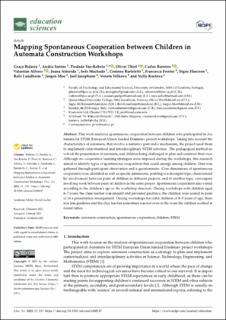| dc.contributor.author | Bidarra, Graça | |
| dc.contributor.author | Santos, Anália | |
| dc.contributor.author | Vaz-Rebelo, Piedade | |
| dc.contributor.author | Thiel, Oliver | |
| dc.contributor.author | Barreira, Carlos | |
| dc.contributor.author | Alferes, Valentim | |
| dc.contributor.author | Almeida, Joana | |
| dc.contributor.author | Machado, Ines | |
| dc.contributor.author | Bartoletti, Corinna | |
| dc.contributor.author | Ferrini, Francesca | |
| dc.contributor.author | Hanssen, Signe Marie | |
| dc.contributor.author | Lundheim, Rolv Sigmund | |
| dc.contributor.author | Moe, Jørgen | |
| dc.contributor.author | Josephson, Joel | |
| dc.contributor.author | Velkova, Veneta | |
| dc.contributor.author | Kostova, Nelly | |
| dc.date.accessioned | 2021-04-08T08:49:27Z | |
| dc.date.available | 2021-04-08T08:49:27Z | |
| dc.date.copyright | | |
| dc.date.created | 2021-03-22T10:53:02Z | |
| dc.date.issued | 2021 | |
| dc.identifier.issn | 2227-7102 | |
| dc.identifier.uri | https://hdl.handle.net/11250/2736781 | |
| dc.description.abstract | This work analyzes spontaneous cooperation between children who participated in Automata for STEM, European Union-funded Erasmus+ project workshops. Taking into account the characteristics of automata, that involve a narrative part and a mechanism, the project used them to implement contextualized and interdisciplinary STEM activities. The pedagogical method involved the presentation of automata, and children being challenged to plan and construct their own. Although no cooperative learning strategies were imposed during the workshops, this research aimed to identify types of spontaneous cooperation that could emerge among children. Data was gathered through participant observation and a questionnaire. Core dimensions of spontaneous cooperation were identified as well as specific dimensions, pointing to a divergent type, characterized by involvement between pairs of children in different projects, and to another type, convergent, involving work between pairs of children in the same project. Spontaneous cooperation also varied according to the children’s age or the workshop structure. During workshops with children aged 6–7 years, the class teacher was present and provided guidance, the children were seated in pairs or in a presentation arrangement. During workshops for older children of 8–9 years of age, there was less guidance and the class teacher sometimes was not even in the room the children worked at round tables. | |
| dc.language.iso | eng | |
| dc.publisher | MDPI | |
| dc.relation.uri | https://www.autostem.info/ | |
| dc.rights | Navngivelse 4.0 International | |
| dc.rights.uri | http://creativecommons.org/licenses/by/4.0/deed.no | |
| dc.rights.uri | http://creativecommons.org/licenses/by/4.0/deed.no | |
| dc.subject | Realfagsdidaktikk | |
| dc.subject | Science Didactics | |
| dc.title | Mapping Spontaneous Cooperation between Children in Automata Construction Workshops | |
| dc.title.alternative | Mapping Spontaneous Cooperation between Children in Automata Construction Workshops | |
| dc.type | Peer reviewed | |
| dc.type | Journal article | |
| dc.description.version | publishedVersion | |
| dc.rights.holder | ©2021 Aurhors | |
| dc.subject.nsi | VDP::Fagdidaktikk: 283 | |
| dc.subject.nsi | VDP::Subject didactics: 283 | |
| dc.source.volume | 11 | |
| dc.source.journal | Education Sciences | |
| dc.source.issue | 3 | |
| dc.identifier.doi | 10.3390/educsci11030137 | |
| dc.identifier.cristin | 1899826 | |
| dc.relation.project | EU/2018-1-PT01-KA201-047499 | |
| dc.rights.license | CC BY | |
| cristin.ispublished | true | |
| cristin.fulltext | original | |
| cristin.fulltext | | |
| cristin.qualitycode | 1 | |

